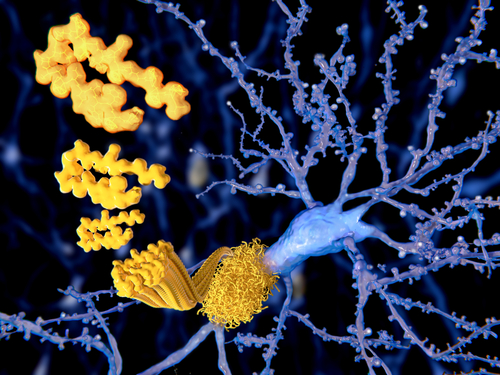Researchers Develop Tool to Detect Alzheimer’s Biomarkers in Several Body Fluids Simultaneously
Written by |

Hong Kong Baptist University researchers have developed a tool for spotting biomarkers of Alzheimer’s disease that can detect them in a number of kinds of body fluids simultaneously.
The tool is made up of antibodies that bind only to beta-amyloid and tau proteins, well-known markers of Alzheimer’s. It uses a new detection compound, an indolium-based turn-on fluorophore that the researchers call SIM. They developed it to be more sensitive than other detection methods.
Researchers said the tool can quantify very low amounts of the proteins simultaneously in cerebrospinal fluid, blood, urine and saliva.
The study, “Ultra-sensitive detection of protein biomarkers for diagnosis of Alzheimer’s disease,” appeared in the journal Chemical Science.
“This newly developed assay will be particularly useful as a low-cost yet accurate diagnostic and prognostic tool for Alzheimer’s disease. It can also serve as a novel alternative non-invasive tool for population-wide screening for the disease,” Li Hung-wing, an associate professor in Hong Kong Baptist’s Department of Chemistry, said in a news release. “This scientific detection assay has a high potential to serve as a practical diagnosis tool,” said Li, the senior author of the study.
Researchers said the tool could be tweaked to help diagnose other diseases by replacing the antibodies with ones that can recognize biomarkers of other diseases.
In addition to the tool, the university has developed a compound that can bind to beta-amyloid protein fragments, preventing their clumping in mice models of Alzheimer’s.
The synthetic cyanine compound, which the researchers call fluoro-substituted cyanine, or F-SLOH, was able to cross the blood–brain barrier and retain its low toxicity. These characteristics support its use as an early detection method for beta-amyloid neurotoxic proteins, as an Alzheimer’s management tool and as a possible treatment for the disease.
Researchers reported the findings in a study titled “Fluoro-Substituted Cyanine for Reliable in vivo Labelling of Amyloid-β Oligomers and Neuroprotection against Amyloid-β Induced Toxicity” in the journal Chemical Science.
The two discoveries have led to four U.S. patents (14/231715, 14/231724, 15/049126, 15/276811) and a Chinese patent.





